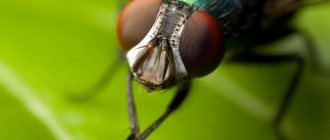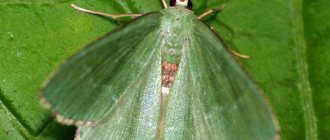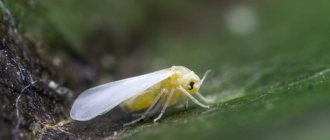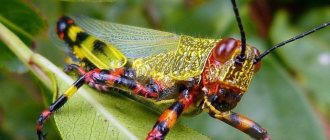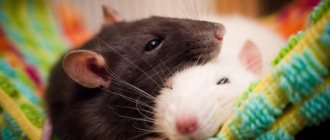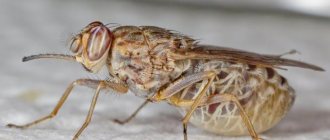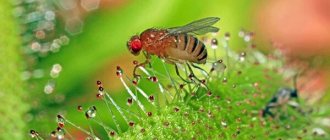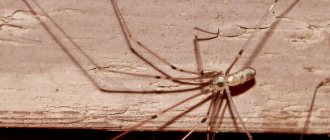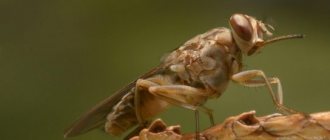The fly is a two-winged nuisance insect from a species of arthropod.
It received this name back from ancient Slavic times from the word “mus”, which translates as “gray”.
What does a fly look like?
Everyone probably knows what this insect looks like, but it’s still worth looking at the presented photos of various flies.
The length of its body ranges from a millimeter level to two cm. The hairy body of the fly has two wings with membranes, a fairly voluminous head and a belly with three pairs of legs.
The mouth is designed like a proboscis that sucks in liquid food. The fly's legs have fairly developed sharp segments and sticky pads that allow it to stay upside down on any surface.
The insect's eyes are designed in a particularly unique way; they contain thousands of hexagonal crystals, which allows the fly to simultaneously see what is happening from absolutely any direction (even the background), that is, it has a circular field of vision. Whiskers are capable of detecting and recognizing many different scents.
Features of the larvae
After 3-5 days, tiny individuals appear from the eggs laid by the female, their length is about 3 mm. They are white, yellow or light brown in color, the cover is saturated with calcium carbonate. This is a kind of protection for larvae and pupae, which subsequently forms inside the shell. They feed on detritus and live mainly in soil and water bodies.
Black soldier fly and its larvae
On a note!
Some of their varieties normally exist in ant nests, manure, rotting wood - and this is their food.
Nutrition of black soldier fly larvae
The feeding process of the larvae deserves special attention; they have an excellent appetite. The tiny head has a beak-like appendage with two movable, jagged, brush-like organs. The beak-shaped process also has one more function: the ability to move the larva along the bottom of the reservoir. It clings to the unevenness and thus moves.
Black fly larvae are not picky about feeding; they feed on absolutely everything that comes their way. This could be: fish, meat, pork and poultry manure. Pig manure is more nutritious for them than cow or horse manure. The quality of manure processing is in many ways superior to manure fly maggots. The difference between black fly larvae and annelids is that they even feed on unfermented fresh foods. The only thing these larvae do not feed on is cellulose. After the larvae process the manure heap, the compost remains and the worms feed on it.
On a note!
The substrate can contain up to 100,000 individuals, resembling a large aggregation of maggots. Such a population can literally process up to 95 percent of various waste in one garbage can in just a few hours, not to mention other sources of their food.
Larval development
The first stage of development is about 14 days, during which time they grow up to 5 mm, but in the presence of favorable conditions for them. The next stage of development lasts ten days, their size doubles. At the third stage, this is the prepupa process, the larvae already reach a size of 20 mm, the color changes to dark brown. This process continues for about 8 days. The cover becomes dense and tough.
Black soldier fly and its larvae
Pupation lasts ½ month. As a result, a full-fledged adult fly emerges from the larva, which subsequently lays its eggs. Thus, their population in nature increases.
Habitats and food of flies
The fly insect is a very heat-loving arthropod and does not tolerate drops in temperature at all. Its habitat is almost the entire globe, excluding cold Antarctica.
They give preference to residential areas, closer to people and animals. The fly can be observed in homes during the warm season, where it invades from early spring to late autumn.
The life of an insect is quite short - a maximum of 2.5 months.
Flies eat almost any organic food that is pre-soaked with their saliva. Sweets occupy the first place in its diet, but there are also exceptional individuals who choose raw vegetables.
Black lion sale wholesale
Black Lionfish for fishing and pet shops
In our own environmentally friendly and waste-free modern production, we raise large, long-lived Black Soldier larvae for fishing and the pet market.
For anglers, we can also produce larvae of the Black Soldier fly (Hermetia Illucens) of medium (for these larvae) size, red in color.
Live marketable black soldier fly larvae are very rare in stores in the Russian Federation.
And if in pet stores in large cities, such as St. Petersburg and Moscow, you can still find the treasured overseas jar, then in smaller cities, in our vast Motherland, this is already an insoluble problem.
The fishing community is 99% unaware of such a product as large, long-lived larvae of Hermetia illucens.
But the unrealized potential of the black soldier fly in the fishing market seems enormous!
Download price list for ordering products
And that's why:
● Black soldier fly larvae in the prepupa stage are simply huge compared to all other maggots that are presented today in fishing stores across the country.
Ninety percent of sales are made up of small larvae of the green carrion fly Lucilia Caesar (or its other subspecies, which are difficult to distinguish from each other even for specialists), the size of which is a maximum of 1.5 cm, and the usual size is 1.2-1.3 mm.
Fishermen, in the spring-summer season, try to purchase larger maggots for catching large fish. The largest larvae of fishing flies are the larvae of various species of the gray striped blowfly Sarcophaga, which reach a length of two centimeters or more and are several times thicker than the larvae of Lucilia. They are in very good demand during the open water season.
In addition, delicate sarcophagus larvae are demanding in terms of storage and transportation conditions, and fishing store owners try to store them together with lucilius larvae (although they have different temperature requirements), which causes damage to the goods.
At the slightest violation of the temperature regime (and the optimal storage temperature for sarcophagi larvae is +10˚C), they either simply die or pupate very quickly.
Due to these and a number of other reasons, sarcophagi larvae have not yet taken their rightful place among fishing baits, despite very flattering reviews about them from anglers who have tested them.
● Hermetia illucens larvae keep very well both at room temperatures and in the refrigerator. When storing in the refrigerator, remember that they cannot tolerate temperatures below +15˚С;
● Black soldier larvae do not pupate for a very long time. which should have a positive impact on the attitude towards them of both the owners of fishing shops and the main consumers themselves - fishermen;
● Black soldier fly larvae for fishing stores can be supplied in a variety of sizes: small, medium (up to 2 centimeters) and large size (in the prepupa stage);
● At different stages of development, the larvae of the Hermetia illucens fly have different natural colors - from the “usual” cream for the usual maggots, to the “exotic” dark in the prepupa stage;
● Black soldier fly larvae tolerate long-distance transportation very well, which will allow the distribution of these products in remote regions;
The next distribution channel for Hermetia illucens fly larvae is through pet store chains. Moreover, both the supply of the larvae themselves and the flies hatched from the pupae, which are very popular as food for various reptiles and spiders, are interesting.
Black soldier flies are weak flyers, so several flies that escape from the container can be quickly caught by hand, and this makes housewives have a positive attitude towards them. In addition, the insects themselves are very beautiful and people buy them with pleasure.
It must be said that black soldier flies are more famous among the zoo community than among the fishing community.
Lion fly larvae are a low-calorie, high-protein food, more dietary than mealworms and zoobass, with an abnormally high calcium content.
Download price list for ordering products
Hoverfly or syrphid
Very similar to a wasp. In the summer, you can see such a fly hovering over flowering plants, or near a cluster of garden aphids.
This specimen is safe for humans. It feeds on the nectar of inflorescences and spider mites. The buzzing of a fly resembles the sound of rushing water, which is why it got its beautiful name.
Gadflies
Horseflies are often confused with gadflies due to the similarity in size. But the difference between them is very big. In terms of harm, gadflies are more dangerous than horse flies. Botflies are also large flies. Their size ranges from 9 to 25 mm. Some of these flies mimic bumblebees.
Gadfly
An adult gadfly does not drink blood and does not feed at all. It is not the fly itself that is dangerous, but its larvae, which parasitize the body of mammals.
Gadflies are widespread throughout Russia. They attack livestock, causing serious damage to livestock production. Parasitic larvae, gnawing passages in soft tissues, bother animals. As a result, livestock reduces weight gain and milk yield.
Gastric gadfly larvae are analogues of worms. The only difference between them is that the larvae come out to pupate, while the worms continue to live in the intestines.
The head of gadflies is flattened and wide. Most species do not have stubble on their eyes. Males have larger eyes and set them closer than females. The oral apparatus is either completely absent or greatly reduced.
Gadflies, compared to horseflies, are fluffy, large flies. The chest of gadflies is covered with stubble. Depending on the type, the bristles can be:
- short;
- long;
- standing;
- adjacent.
The thick, short legs are also covered with dense hairs. The wings are transparent. The abdomen can be conical or spherical.
Photo of a fly
Cockroaches in the house: dirt and unsanitary conditions
Cockroaches are perhaps the most famous household pests. The photo below shows their species that settle in apartments - naturally, against the will of the owners.
Of course, the first place is occupied by one of the most numerous and well-known household insects - the red cockroach (which also has another name “Prusak”):
The second species, quite familiar to our latitudes, is the black cockroach (Latin name Blatta orientalis). This is a relatively large domestic insect, gradually disappearing under the onslaught of its red-haired fellow (the Prussian actively eats the eggs of the black cockroach).
Photo of a black cockroach:
The third type of these pests is the American cockroach (Latin name Periplaneta americana):
Initially, it was extremely rare for our country, but with the development of international trade, this species began to conquer warehouses and shops in large cities, and only then - residential premises located nearby.
The key to the successful “occupation” of human housing by these domestic pests lies in the peculiarities of their biology. Cockroaches are insects that feed on absolutely any food waste in the house, as well as many other household items - for example, various adhesives, shoe polish, paper. In addition, they can go without food for quite a long time - sometimes even up to 20 days.
Below are a few more photos of these household pests:
Cockroaches reproduce very quickly, and the lifespan of an adult is approximately 9-16 months.
In addition to the obvious harm that cockroaches cause to various food products (eating, contaminating them), they, among other things, are carriers of various infectious diseases and even the eggs of some helminths.
Therefore, the fight against these domestic insects must be carried out.
"Vagrant" insects in the house
All other insects that can be found in a person’s home are most rationally classified as random “stray” guests. This group includes various butterflies, beetles, cicadas, stink bugs, ladybugs, as well as wasps, bees and hornets.
There is no point in deliberately destroying them, but for your own peace of mind and safety, it is enough to simply release the insects out of an open window. You just need to be careful with some of them - they can sting (for example, a hornet) or seriously spoil the air (for example, a stink bug).
About parasitic insects and means of getting rid of them
Reproduction
Reproduction in dipteran insects occurs sexually. There are pedogenesis (reproduction at the larval stage) and parthenogenesis (development without fertilization, males are rare or unknown).
This unit undergoes a complete transformation. Most often, representatives of Diptera lay eggs, and some species are characterized by viviparity. Then, complete or partial development of the larva occurs in the female’s reproductive tract.
Silverfish are harmless observers
Silverfish are perhaps the most “quiet” and practically harmless species of domestic insects. In terms of their lifestyle, they can be compared, for example, with woodlice: these small human companions also love moisture, darkness and warmth.
The photo shows the most common species - sugar silverfish (otherwise - common, Latin name Lepisma saccharina):
These domestic insects feed on various organic matter, which they find in dust, sugar on the table, bread crumbs, and sometimes everything that the carpet beetles, mentioned above, prefer.
Silverfish never breed in large quantities and are seen mainly in the evenings, when the owner of the premises, turning on the light, takes the insects by surprise (by the way, these human neighbors have impressive speed for their size and quickly hide in safety shelters).
Silverfish are rarely controlled purposefully and are usually bred in parallel with other synanthropic insects. For this purpose, as a rule, various aerosol insecticides are used, although you can get rid of them in the simplest ways - cold or dryness in the house.
It is also useful to read: Types of insects that can live in an apartment and their photographs
And one more thing: What kinds of insects do not live at home - detailed descriptions and photographs. A terrible thing... (the article has more)
Mushroom flies / Platypezidae
The remains of this family were discovered in deposits of the Cretaceous and Jurassic periods, and today more than 250 species have been described in science. This is a small fly whose larvae feed on mushrooms.
The habitat is forests. The body is black with small white spots. They have fairly large wings in relation to their body. Clearly defined head with large eyes.
In the forest you can often find mushrooms whose caps are eaten away by Platypezidae larvae. This new family was first discovered and described by the famous Swedish entomologist Carl Frederick Fallen in 1815.
Don’t miss out, there is a fascinating article about the most beautiful mushrooms on our website most-beauty.ru.
9
Lice: always nearby - both in the house and on the street
The louse is a classic blood-sucking parasite. These insects are not attached to the house, but directly to the person himself, and are not capable of living outside his body or at least clothes. That is why lice cannot be called typical household insects.
The photo shows a head louse, which, among other things, is a carrier of some dangerous infectious diseases:
And the photo below shows a pubic louse, the presence of which is considered a venereal disease (another name is the louse, Pthirus pubis):
Adult parasitic lice and their larvae spend most of their time tightly clinging to human hair, and to feed, they crawl to the surface of the skin every few hours. Their eggs in a dense shell are called nits and greatly spoil the appearance of the hair.
Due to the fact that lice feed on human blood and, accordingly, constantly bite him, their presence causes severe itching. Today there is a large arsenal of specialized lice products: pediculicidal shampoos, sprays and combs.
Woodlice in the house are not exactly insects
But woodlice (as already mentioned at the very beginning) cannot be classified as insects living in the house - these arthropods belong to the class of higher crayfish.
This photo shows the common armadillo (Latin name Armadillidium vulgare):
And here is the rough woodlice, a more frequent guest in homes:
They, unlike, for example, typical bedbug parasites, do not cause any particular harm to humans: only occasionally do woodlice spoil stocks of vegetables or (if they get there) damage young parts of indoor plants. However, meeting these miniature roommates is always unpleasant.
As a rule, wood lice appear in rooms where high humidity is constantly maintained or there are water leaks: usually these are bathrooms and toilets. Here, there is an abundance of secluded dark shelters (woodlice, like cockroaches, do not like bright light), and a food source - for example, a trash can, in which you can feed on various organic debris.
The existence of woodlice is to one degree or another connected with water (after all, they are crustaceans), so it is quite easy to remove them.
In most cases, all that is needed to do this is to eliminate the moisture that is vital for them: dry the bathroom or, for example, fix a leak in the faucet. If these measures for some reason do not bring the desired effect, then woodlice can be exterminated with any modern insecticidal agent (Get, Delta-Zone, Tsifoks, Dobrokhim FOS, etc.).
Insects - pests of a wooden house
A number of insect pests of wooden houses deserve a separate discussion. They do not live indoors and are not visible, but their active life can lead to a decrease in the strength of wooden structures and even subsequent destruction of the building.
Among such insects that live in a wooden house, one can distinguish carpenter ants, grinder beetles, some moths, and in the south of our country - termites. To protect against these pests, house structures are treated with special stains or impregnations during the construction stage, and then regularly painted.
The photo shows a red-breasted carpenter ant (Latin name Camponotus herculeanus):
And here is a beetle grinder:
In this photograph you can see a termite - a typical inhabitant of Turkmenistan, sometimes penetrating into the southern regions of our country:
Mosquitoes: guests for several days
It is difficult to imagine a person who would not know what mosquitoes look like. These insects appear in the house for a short time only to drink blood and fly back outside to lay eggs.
Only females are bloodsuckers (they need blood to produce eggs), but males, as a rule, feed on plant nectars.
The common mosquito, the most common biting parasite in our country (another name is the squeak mosquito, Culex pipiens):
And the next photo shows a malaria mosquito - an insect commonly found in the homes of people living in the tropics and carrying the corresponding disease. The photo shows how he holds his body - this is the main way to distinguish an anomaly mosquito from its ordinary counterpart:
On a note
Many other species of mosquitoes are also capable of transmitting life-threatening infectious diseases. Fortunately, this problem practically does not affect our latitudes, and the only thing that a mosquito can be dangerous for the population of our country is the severe itching that appears after the bite.
The development of mosquitoes is always closely related to water, so houses with flooded basements are an ideal place for the breeding of these blood-sucking parasites. Also very often, these insects are found in private homes and cottages, where they always have an accessible source of moisture nearby.
Today there are a great variety of remedies for mosquito bites: these include ointments, creams, and various other forms of repellents. The main way to prevent these domestic insects from entering an apartment is mosquito nets attached to windows, as well as maintaining the basement and courtyard areas in good condition.
Springtails
In a person’s apartment, springtails are frequent inhabitants of flower pots, and if we talk about homestead farming, they can often be found in greenhouses and greenhouses.
Springtails are very small domestic insects (some modern scientists tend to classify them as a separate class). In the photo you can see these miniature “neighbors” on a lump of earth from a flower pot:
Springtails begin to cause damage only when there are a lot of them: they damage the underground parts of plants and, occasionally, low-lying leaves.
These domestic insects live only in a humid environment, so when they appear in the soil of plants, you must first try to reduce watering as much as possible. In addition, experienced gardeners advise adding special preparations to water for irrigation, and as a preventive measure, using prepared, disinfected soil for planting and creating drainage in the pot that will prevent water from accumulating.
Fleas: defectors from pets
Unfortunately, the list of domestic blood-sucking insects does not end with the bugs mentioned above. Fleas are another parasite that can often be found in human homes.
It is also useful to read: How to deal with small insects in the bathroom and toilet
And one more thing: Really working remedies for insect bites
They and bedbugs most often bite in the house.
By and large, fleas do not have a “permanent place of residence”: they can be found both in apartments and in the wild. In the house they usually stay close to the resting places of domestic animals, on which they parasitize, feeding on blood.
Fleas are common domestic blood-sucking insects that easily pass from one host to another (for example, to humans). They need blood both for nutrition and for reproduction - without it, the eggs inside the female simply do not develop.
The photo shows one of the most common fleas - the cat flea (Latin name Ctenocephalides felis):
Fleas are potentially capable of carrying many deadly diseases - from plague and typhus to encephalitis and brucellosis, and therefore they need to be dealt with especially diligently. But even if there is no infection in a particular insect, its bite itself is quite painful, causes severe itching and, as a consequence, the appearance of pustular inflammation on the skin.
Removing fleas in general is not that difficult if you act correctly. Firstly, it is necessary to poison these parasites on pets, in their bedding and resting places. Secondly, you need to treat the entire apartment, because flea larvae can be found in floor rags, in floor crevices, and behind baseboards.
